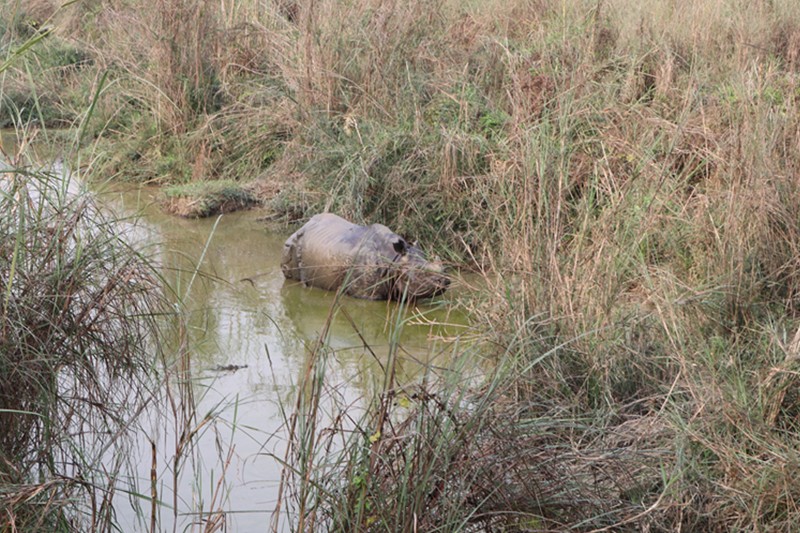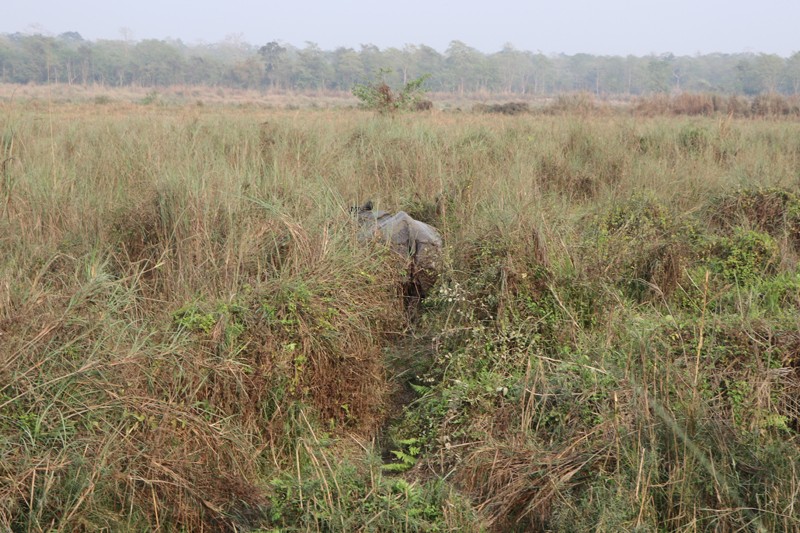In mid-January of 2023, a female rhino and her cub were killed by poachers in the western region of Chitwan National Park (CNP) through the use of an electric ambush. The naked electric wires were laid on the ground in a place close to the settlement around the temple. This new way of poaching has added to an already-challenging rhino conservation effort of the country. “Poachers have devised a new method to kill rhinos,” said Hari Bhadra Acharya, then chief of CNP. “This truly is worrying.”

The new method adopted by poachers and wildlife parts smugglers to kill rhinos has equally worried conservationists as this cruel method poses a genuine threat to the existence of wildlife.
Five types of rhinos are in existence worldwide – white rhino, one-horned rhino, black rhino, Javan rhino, and Sumatran rhino – of which the one-horned rhinos are mainly found in India and Nepal. Such rhinos are also found in the jungles of Bhutan. According to the 2022 State of the Rhino Report, there are around 4,018 one-horned rhinos in the world among which 752 are in Nepal and over 3,000 in India. The Kaziranga National Park located in India’s Assam hosts 2,613 rhinos – the largest number – while Nepal’s Chitwan National Park has as many as 694 rhinos.
Though the number of one-horned rhinos has been increasing since 1980, it still features in the red list of the International Union of Conservation of Nature (IUCN), the global body which prepares the list of the world’s endangered animal and plant species. The IUCN, so far, has studied the status of over 157,100 species in the world, of which over 44,000 are at the risk of extinction. The IUCN’s list of species facing threat of extinction includes amphibians, mammals and birds and the one-horned rhino is one of those species. Criminal activities such as poaching, theft, and smuggling have posed a threat to conservation of one-horned rhinos globally.
In Nepal, poaching contributed to a sharp decline in the number of one-horned rhinos in 1965 – reducing the number to 100. A decade prior to that in around 1955, there were approximately 800 rhinos in Chitwan National Park and other forest areas of Nepal. Armed rhino patrol, establishment of national parks and other measures to control poaching have contributed to the increase in rhino population to 752, according to the latest national rhino count of 2021. According to this count, there are 694 rhinos in Chitwan National Park, 38 in Bardia National Park, 17 in Suklaphanta National Park and three in Parsa National Park – of which 520 were adults, 96 semi-adults and 136 cubs and calves. This is the largest rhino count in Nepal after the national count in the 1950's.
While the encouraging growth in the number of one-horned rhinos has brought a cheer among the conservationists, they are worried of the challenges to the conservation of rare species. For conservationists, poaching is a ‘permanent challenge’ to rhino conservation. Moreover, shrinking habitat, pasture land, and loss of water sources are considered to be additional challenges. According to Dr Ganesh Panta, a conservationist, encroachment on pasture land and habitat, coupled with sudden flooding induced by climate change, can further add to the conservation challenges. “Our studies show that if adaptation efforts are not taken on time, climate change impacts can become a cause of additional challenge to rhino conservation,” said Dr Panta, who studies this trend and who in the past served as Information Officer at the Department of National Parks and Wildlife Conservation. “At the same time, we must not forget the permanent challenges such as poaching and human-wildlife conflict,” he added. The Department of National Parks and Wildlife Conservation is alarmed by a recent rise in rhino poaching, particularly the targeting of rhino feet alongside horns. The poachers' development of new killing methods further compounds these concerns.
Crime and punishment
On January 20, 2023, a mother rhino and her cub were killed in Madhyabindu Municipality-2, on the banks of Narayani River near Seheri village, which lies in the buffer zone of Chitwan National Park. The poachers had used an electric ambush to trap the wildlife. The Central Investigation Bureau (CIB) of Nepal Police arrested three persons in connection to this crime on May 26, 2023. Those arrested were Krishna Bahadur Mahato, Sikharam Tharu and Hom Bahadur BK, residents of Ramgram Municipality-18, Dharampur. They are in judicial custody at the moment and investigation into the case is underway, according to authorities of the National Park.
On November 16, 2023, two female rhinos, aged six and 18 respectively, were found killed in a location close to Badela River in Chaparchuli on the eastern side of Chitwan National Park. The poachers had dug a pit – a conventional method used by poachers – to ensnare the rhinos. According to the Department of National Parks and Wildlife Conservation, an investigation into the case is underway.
These incidents show that poachers have been using both conventional and ‘innovative’ methods to kill rhinos, adding further challenge to rhino conservation efforts in Nepal.
Electric ambush: How old is the practice?
Conservationists argue that using electric ambush for rhino poaching is not a completely new practice. Ajay Karki, Deputy Director and Spokesperson at the Department of National Parks and Wildlife Conservation, said that such traps have been used since as early as 2007. “Poachers had used an electric ambush to kill rhinos in 2007 in Jagatpur, a place close to Chitwan National Park,” he said. “It is after quite a considerable time that poachers have again resorted to electric ambush to kill rhinos,” he shared.
This latest incident in mid-January whereby poachers killed the rhinos by electrocution in the CNP has alarmed the park administration. “When rhinos used to enter the settlement areas and destroy crops, the local people would ambush and kill the rhinos in the past too,” said Ganesh Prasad Tiwari, Assistant Conservation Officer and Information Officer at Chitwan National Park, who has been studying the latest trend in poaching. “But during such incidents, horns, feet and vital parts of the dead rhinos would be intact. However, in the recent incidents, horns have been cut off proving the involvement of poachers,” he said, adding, “This is troubling.”
Incidents of residents around the national park setting up ambushes and killing rhinos are on the rise. In September, locals of Khairahani Municipality-12, an area located in Kumrok Community buffer zone in Chitwan, used electric wires to electrocute a rhino. “Such incidents are the results of human-wildlife conflict,” said Karki, adding, “The department is alert about such incidents but the Seheri case caught us by surprise.”
According to available records, a total of 321 rhinos have died in the last 15 years, of which 32 were killed by poachers and two were electrocuted. At the same time eight more rhinos were killed through the use of electric ambush.
Is electrocution becoming a new normal?
Experts involved in the study of rhino poaching say the incidents in Chitwan cannot be taken as a shifting trend in rhino poaching. “But the possibility of this becoming a new normal in rhino poaching remains strong,” said Karki, who is also the coordinator of the study team. “Incidents of rhinos being killed by electrocution for their horns are rare,” said Rupak Maharjan, Assistant Investigation Officer and one of the six members of the study team at CNP. “In over two decades of my experience in wildlife crime control, I had never seen such an incident,” revealed Maharjan, who has been working in the Wildlife Crime Control Division of the Department of National Parks and Wildlife Conservation. According to him, there is access to electricity in nearly all areas where rhinos are found. “The real fear and concern at the moment is that the poachers could use it [electricity] as a weapon.” According to CNP, a total of 14 rhinos have died this year. From among them, three died through electrocution and two were killed by poachers.
Ramprit Yadav, a conservation activist who has been actively working since the establishment of national parks in Nepal, sees the latest poaching by electric ambush in Chitwan as an indication of poachers using electricity as a new weapon. “The earlier trend was to dig pits around rhino habitats and killing the rhinos with weapons after they fell into the pits,” he said. “Later, they started using sharp weapons and guns,” he states. Yadav, who has been working as a conservation activist since 1970 and who also served as a member in a committee formed for the establishment of CNP, says that poachers have now started to use electric ambushes. “From spears and guns, the poachers have started using electric ambushes now,” he said. “It looks like they have studied the local circumstances well and are putting up electric ambushes. There is a possibility of this happening in other buffer zones as well because there is access to electricity everywhere,” he mentioned.
Poaching in number
Though rhino poaching has decreased by a considerable extent in recent times, incidents of poaching still continue. Ajay Karki, Deputy Director at the Department of National Parks and Wildlife Conservation, admits that though zero poaching had been ensured for a few years, incidents of poaching have started to rise again. CNP, which is the chief habitat of rhinos in Nepal, marked five consecutive fiscal years – 2014/15 to 2019/20 – as years of zero poaching, which means, poachers did not kill rhinos during this period. But last year, four rhinos were killed across the country in various poaching incidents. According to conservationist Dr Shantaraj Gyawali, attention must be paid toward loss of habitat and its accommodation capacity. “This, however, does not mean that we don’t need to work on poaching control. We need to do it continuously because poaching for smuggling is a permanent challenge,” said Gyawali. “Poachers have been exploring new methods in recent times and they have now shifted to using electric ambushes. Conservationists need to be vigilant about this,” he stressed.
The Central Investigation Bureau of Nepal Police has been assisting in wildlife crime control efforts. According to CIB, for the first time after 2017, original rhino horns were confiscated from smugglers this year. Of the 16 horns recovered by the police from smugglers from 2013 till date, only three were original. According to Hirendra Rokaya, inspector of police, an original rhino horn was recovered from smugglers on January 5, 2024. “After tracking the network of the smugglers, we were able to arrest 15 people involved in the case,” he said. “We need to continuously investigate and monitor the cases of rhino killing and sale and purchase of horns to get to the bottom of the cases,” he stated.
Inadequate legal safeguards
According to the National Parks and Wildlife Conservation Act (1973), any person who illegally kills wildlife is subject to a fine ranging from half a million to one million rupees or an imprisonment ranging from five years to 15 years or both. But the same Act also mentions that if the residents living around buffer zones are left with no option but to use arms or take any other measures against wildlife to save lives and to protect their crops and livestock, and if any wildlife is killed or wounded in such action, it shall not be considered a crime.
In neighboring India, the Wildlife (Protection) Act (1972) and the Electricity Act (2003) prohibit farmers from putting up electric fences. In the United States provisions and limitations regarding the use of electric fences differ from one state to another. Provisions related to electric fences and their basic standards are determined beforehand.
Though legal provisions in Nepal are clear about crime and punishment, they are silent about the use of electric ambush and its lethal impact on wildlife as well people living in the vicinity, resulting not only in the deaths of wildlife but also humans.
On February 10, 2023, Khem Shrestha, a local of Birtamod in Jhapa district, himself fell into the electric ambush, which he had apparently set up to save himself from wild elephants, and died. Likewise, in September 2021, three members of the same family died in Thakur Baba Municipality, Bardiya, when they fell into the electric ambush set up to kill wild boars.
Dr Ganesh Panta, Information Officer at the Department of National Parks and Wildlife Conservation, said that gathering information regarding such incidents is not under the jurisdiction of the department.
However, he explains that to prevent such incidents from taking place, in the last two decades electric fences in buffer zones around national parks in the Tarai have been made in such a way that they automatically repel anybody who touches them. But there are no clear guidelines or standards about such practices. “There are no laws related to electric fences,” said Dr Panta, adding, “They are utilized only on need basis to manage human-wildlife conflict.”
Neither does the Department of National Parks and Wildlife Conservation nor the National Trust for Nature Conservation (NTNC) has exact and detailed information about the expenses incurred in setting up electric fences since the 1990s. According to statistics made available by the Department of National Parks and Wildlife Conservation, since 1997, over Rs 123.8 million has been spent to install around 350-kilometer-long electric fences in various parts of the country. According to NTNC, electric fencing started from Bardiya National Park in 1997. While NTNC estimates the total spending on electric fencing to be more than Rs 200 million, it does not have accurate data about the same.

Nonetheless, the use of electric fencing has continued. It was installed in Koshi Tappu National Park last year. Bikki Lakha, an engineer who worked on that project, said electric ambush and electric fencing are two different things altogether. “Power of four to 10 volts is transmitted in an electric fence,” he said, adding, “Moreover, it is based on direct current (DC) which means the power keeps going off and on.” He further states that in an electric ambush, however, the smugglers connect the naked wires directly by hooking which is lethal for both human beings and wildlife.
What may be done?
“The methods of crime appear to be changing with time,” admitted Karki, the Spokesperson at the Department of National Parks and Wildlife Conservation. “As a result, strategies, techniques and technologies in monitoring and inspection also need to be upgraded.” According to him, wildlife crime control officials need to be able to strategize in a much smarter way than the criminals and work proactively. “There are cases of poachers and smugglers using guns with silencers to kill wild animals such as rhinos in foreign countries. We need to be watchful to see if criminals here bring in such techniques.”
According to the Department, it is studying if the smugglers are using the new techniques to elude conservationists and wildlife crime control authorities. According to Karki, all national parks, reserves, protected areas and concerned security agencies have been made aware about the need to be alert about the changing methods of wildlife crimes, including rhino poaching. Conservation activist Ramprit Yadav is of the view that community-based conservation efforts should also be put in priority. “Of course, we need the help of administrative and security agencies but the community plays a pivotal role in combating poaching,” he said. “In particular, we need to ensure participation of people around buffer zones in this initiative,” said Yadav, who has been working consistently in the conservation area for the last five decades. “We need to educate them about the new methods the poachers are using and the ways to report them to the authorities. Only then can the conservation efforts be successful.”
Read our guidelines for Republishing this story here.



